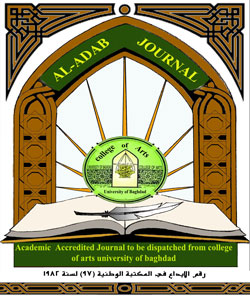The Theme of Loneliness and Isolation in Sherwood Anderson's Fiction
DOI:
https://doi.org/10.31973/aj.v0i112.1542Keywords:
/Abstract
The aim of this research is to study the American writer Sherwood Anderson( 1876-1941 ) and his contribution in the American fiction in one of its most remarkable phases : that period of change and literary experimentalism that occurred after the First World War. In this period a new passion and consciousness comes into American writing .It is also thought of as a classic era of materialism, and business - ethics which the writers regularly condemned and expatriated themselves from it. The sense of loneliness and isolation is apparently depicted in Anderson's writings as a clear reflection of the general sense of American society at that time with the spread of commercial and industrial tendencies. The research tries to shed light on this theme in Anderson's major selection of short stories Winesburg, Ohio(1919) as well as in other works like The Triumph of the Egg (1921) and his novel Poor White(1920)
Downloads
References
---------------------- The Triumph of the Egg. New York: Perma Books, 1980.
----------------------- Poor White .New York: Perma Books 1980.
Cowley, Malcolm. Writers at Work. London: Penguin Books, 1962.
Encyclopedia Britannica 2010, Deluxe Edition C D .
Geismar , Maxwell. The Last of the Provincials. Boston: Twayne 1999.
Howe, Irving. Sherwood Anderson. New York: Collier Books1951.
Lewis, Ray (ed .) The Sherwood Anderson's Reader . New York: Appleton 1960.
Schevill , James. Sherwood Anderson: His Life and Work . Denver: Alfred A. 1951
Spindler, Michael. American Literature and Social Change London: MacMillan Press Ltd.1996.
Way, Braian. “Sherwood Anderson “in The American Novel and The Nineteen Twenties. London: Edward Arnold, 1982
Downloads
Published
Issue
Section
License
Copyright and Licensing:
For all articles published in Al-Adab journal, copyright is retained by the authors. Articles are licensed under an open access Creative Commons CC BY 4.0 license, meaning that anyone may download and read the paper for free. In addition, the article may be reused and quoted provided that the original published version is cited. These conditions allow for maximum use and exposure of the work.
Reproducing Published Material from other Publishers: It is absolutely essential that authors obtain permission to reproduce any published material (figures, schemes, tables or any extract of a text) which does not fall into the public domain, or for which they do not hold the copyright. Permission should be requested by the authors from the copyrightholder (usually the Publisher, please refer to the imprint of the individual publications to identify the copyrightholder).
Permission is required for: Your own works published by other Publishers and for which you did not retain copyright.
Substantial extracts from anyones' works or a series of works.
Use of Tables, Graphs, Charts, Schemes and Artworks if they are unaltered or slightly modified.
Photographs for which you do not hold copyright.
Permission is not required for: Reconstruction of your own table with data already published elsewhere. Please notice that in this case you must cite the source of the data in the form of either "Data from..." or "Adapted from...".
Reasonably short quotes are considered fair use and therefore do not require permission.
Graphs, Charts, Schemes and Artworks that are completely redrawn by the authors and significantly changed beyond recognition do not require permission.
Obtaining Permission
In order to avoid unnecessary delays in the publication process, you should start obtaining permissions as early as possible. If in any doubt about the copyright, apply for permission. Al-Adab Journal cannot publish material from other publications without permission.
The copyright holder may give you instructions on the form of acknowledgement to be followed; otherwise follow the style: "Reproduced with permission from [author], [book/journal title]; published by [publisher], [year].' at the end of the caption of the Table, Figure or Scheme.












